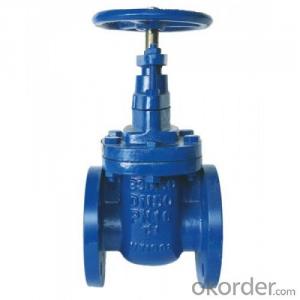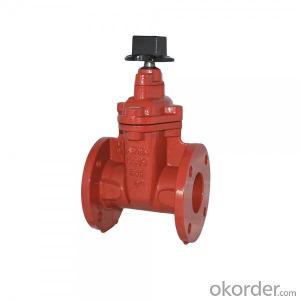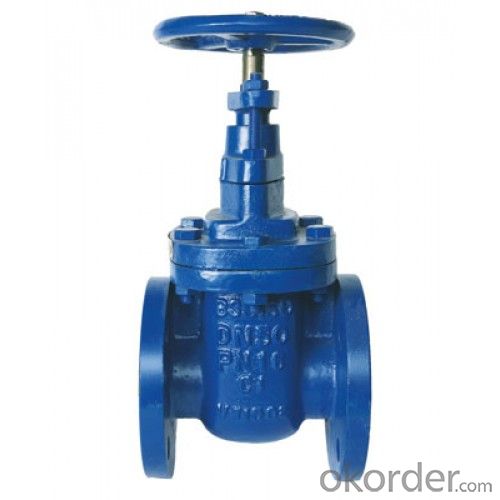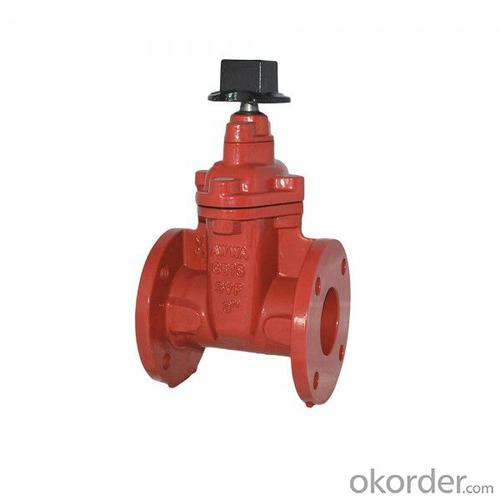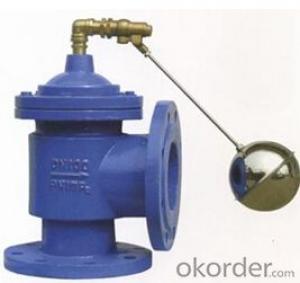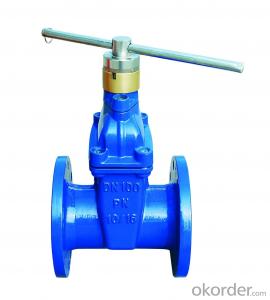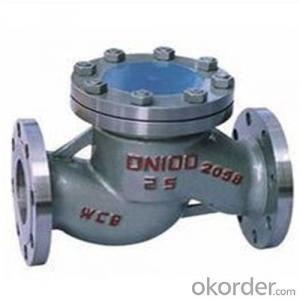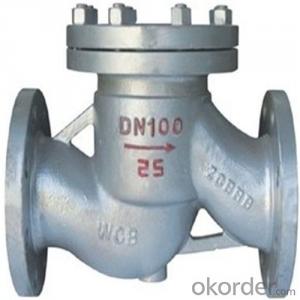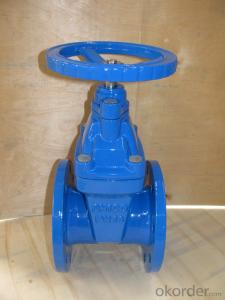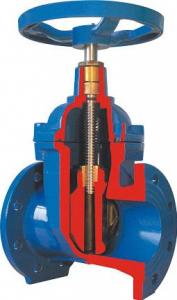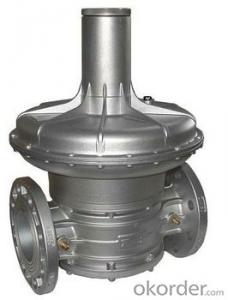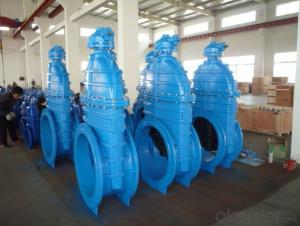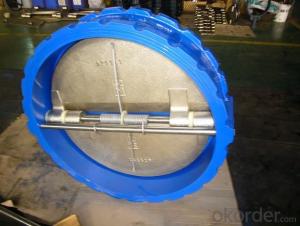Ductile Iron Gate Valve Non-Rising Stem of DIN3352
- Loading Port:
- Tianjin
- Payment Terms:
- TT OR LC
- Min Order Qty:
- 10 unit
- Supply Capability:
- 100000 unit/month
OKorder Service Pledge
OKorder Financial Service
You Might Also Like
Non-rising resilient seated gate valves solve the problem in general gate valves such as leakage, rusting etc. and saves installation space. It is used widely in tap water industry, sewage treatment, shipping construction, petroleum, chemicals, food, pharmacy, textile, electric power, metallurgy and energy system's pipeline to adjust and shut off fluids.
l Replaceable O-ring
l Low torque operation
l Rubber encapsulated wedge
l Clockwise closing direction
l Fusion bonded epoxy coated inside and outside
Specification
Body materials: Ductile Iron
Design standard: DIN3352 F5
Design pressure: PN10/PN16/PN25
Size: DN80mm-DN2000
Connect type: Flanged gate valve
Seal type: Resilient seated gate valve, EPDM+ Ductile Iron
Coating:
Fusion bonded epoxy coated both on the interior as well as the exterior surfaces of the valve, flange surfaces are also fully epoxy coated, blue color.
Application
Potable water, neutral liquids, irrigation, heating and chilled water, fire systems etc, in either above ground or buried service applications and requires minimal maintenance
Feature
This Ductile Iron Resilient Seated Gate Valve is fully compliant to DIN3352 F4. We have light weight type, heavy weight type and even middle weight type for your reference, and these three options design construction of ductile iron will offer a robust and durable extended life performance.
1- Bolted bonnet, full bore: used for larger valves and higher pressure applications.
2- Stem sealed with O-rings: realize zero leakage, could be replace under full pressure.
3- Rubber encapsulated wedge: excellent elastic memory, ensure sealing effect.
4- Blue fusion boned epoxy coated inside and outside: suitable for portable water.
5- Working pressure from -1 to +16 and working temperature from -10 to +80°C
Durable
This valve is suitable for use in a wide range of applications including potable water, neutral liquids, irrigation, heating and chilled water, fire systems etc, in either above ground or buried service applications and requires minimal maintenance. This Resilient Seated Gate Valves have a rated working pressure of 16 Bar. The valves seal 100% leak tight. The waterway is clear, unobstructed and free from pockets. Resilient seated gate valves are fusion bonded epoxy coated both on the interior as well as the exterior surfaces of the valve, flange surfaces are also fully epoxy coated.
Advantage
1- OEM Factory : Professional manufacturer, clients from whole world.
2- High Quality, Competitive Price: Custom is accepted.
3- Complete Service: Long service Life, Fast delivery, Multilingual services.
4- Certificates: ISO9001, CE, NSF, TS, WRAS.
5- Low MOQ: Ready for providing the sample and producing some small orders.
FAQ
Q: Are you manufacturer of trading company? Which kind of valves do you supply?
A: We are a professional manufacturer of butterfly valves, check valve, non-return valves, gate valves, Y-strainer and so on.
Q: Will you do inspection before shipment? Whether Third Party Inspection is available?
A: We have a professional engineer team, so we can offer you the most professional technical support. All valves are tested twice before and after hammer pin to ensure its perfect sealing property and to make sure every valve is ok before ex-factory. TPI is ok but the clients should bear all fees.
Q: What kind of package do you use for these valves?
A: Valves from DN80-DN1400 will be packed in wooden boxes, but valves above DN1400 will be in wooden pallets. If you need wooden boxes for above DN1400, the price may be more expensive.


- Q: I am working on my riding mower Briggs and Stratton 15.5 OHV. After replacing my headgasket my intake valve did not move when I turned shaft by hand. I took it back apart and believe I have my pushrods positioned correctly but cannot seem to get the rockkers back over the valves and rods. Maybe its because I am a girl and just need to man up but I thought it should be easier. Anyone got any tips?
- Okay, here we go. I have been doing this for 150 years, so I think I know why you are having the problem. The piston must be at Top-Dead-Center (TDC) on the FIRING stroke. Both valves will be what is known as On The Rock. That is or means the push-rods will be resting on the camshaft inside the engine where there is no lift (bottomed). The best way to find this out is to look at the flywheel and see where the magnet is in relation to the ignition coil. The engine actually fires twice (it's just the way it is), but if yo see the magnet on the ignition coil then chances are you are either at TDC on the compression stroke or BDC on the induction stroke. Confused yet? Let's make it easy to tell the difference. When the piston is at TDC the piston will be at the to p of the bore and the magnet will be on the ignition coil. The valve push-rods will be at the same height. This is when you fit the rockers. As you can see there will be two nuts or a single nylock nut that has a nylon insert. If you have the nylock nut then then just tighten the inlet to 0.007 and the exhaust to 0.010. The same applies with the two nut system, except that when you have set the gaps you have to spin the locking nut down and hold the set nut (the first one) and then tighten the other nut down tight to the set nut. But I guess you knew all this, eh. Good to go, eh. I hope I might have been some help. mmalky: 50 years fixing small and large lawnmowers.
- Q: Glob Valve or Gate Valve
- Gate valve is commonly used.
- Q: I am looking at getting a baritone horn of my own, but am not sure what compensating versus non-compensating valves are?
- A compensating valve instrument has valves that send the air through two sets of tubing. For example a double French horn has slides for the F side and the Bb side. In a normal horn the air goes through the F side when you are playing the F side and the Bb side when you are playing that side. In a compensating horn when you play the F side the air goes through both sets of slides. It's a way of making the horn lighter and simpler.
- Q: i recently adjusted my valves on my 01 civic with a 1.7 sohc vtec motor and i did it to the specs under the hood and i didnt have them too tight or too loose on the feeler gauge and they are pretty loud are these motors just that noisy? has anyone else adjusted them to something different that works better?
- The dude above is physically powerful, yet incorrect on the fee. you may get an entire swifter equipment for about 1k, a reliable setup will fee a million.5k to 2k with injectors, gasoline pump, a turbine, and an intercooler. 01 are heavy and not super to do mods to, additionally d16 sucks inventory, so which you're able to additionally could desire to yet internals with expenses 900 for the aspects (pistons and rods). entire could be 2k to 3k for an extremely super setup for 250 to 300hp
- Q: Are all the valve created games tied together somehow? Except for TF2 like in portal 2 glados says she might start a hobby of reanimating the dead so is that left 4 dead?
- there are lots of possibilities. in left 4 dead Ellis once said he played team fortress 2 and Louis has played half-life. plus in portal there are several references to black mesa which was in the first half-life, also in half-life episode 2 you see an aperture science ship called the Borealis which hints at what happened in the time of portal 2. so in turn there are plenty of connections of between the valve universe's but no actual crossover has actually happened. but a big connection between two games i cant quite figure out. in left 4 dead 2 at the dark carnival you can win a garden gnome in a shooting gallery, if you can get the gnome all the way to the end of the level you win an achievement. but strangely in half-life episode 2 you can find a garden gnome at the beginning of the game and get it all the way to the base where you can stick inside a rocket where later you can blast it off into space! whats strange about this is there no clear connection between half-life 2 episode 2 and left 4 dead 2, since its already established that half-life is a video game in the left 4 dead universe. i mean in fiction most crossovers involve some kind of dimensional rift or tare, or even a portal...wait a second.
- Q: We've got a one-handled faucet for the tub/shower and it has that pressure-balancing mechanism. We have it set, I think, so that we can take the hottest showers possible, because our water heater lacks enthusiasm. However, when I want to draw a bath for the baby, I need it to be lukewarm - and I have to turn it almost OFF to get the water to be even tepid. I can't get cold water out unless it's only trickling. As far as I can tell, our cold water pressure isn't different from the hot (bathroom faucets are 2 handles and H C seem to be about the same pressure). Is there a way to adjust the valve in the shower so I can get both the hottest possible, and the coldest possible water at full pressure?
- the new single handle tub and shower valves all come with a scald guard mechanism.(its code so kids cant turn on the hot and burn themselves). take the handle off and mess with it. it will be grey or black with a bunch of grooves on the outside. keep adjusting it till it satisfies you.
- Q: Hi there - We have an old house with galvanized steel pipes. Our main water shut off valve leaks -- the leak is from the packing nut. A plumber came out yesterday and tightened it, and it now barely leaks at all, maybe one drip every 24-48 hours (which it probably has been doing for the 6 years we have lived here, we just didn't know when we bought the place). Rather than replacing the whole valve (which, apparently, has a high liklihood of breaking the pipes in the foundation, requiring jackhammering and whatnot), we are thinking of installing a new shut off valve higher up on the pipe, where I guess it's less likely to break. If we go for the second valve, is there a way to close up that old valve (hydraulic cement, tape, solder, etc.), so it doesn't leak at all? The tiny leak is coming from the stem of the handle - can we remove the handle and cap it off or something? (And thanks to those of you who answered my husband's question about the pipes yesterday!)
- There is a very simple fix to your problem. Get some teflon tape, turn off the valve, back off the packing nut all the way, twirl the tape into a thread (about 4 to 5), wrap it around the stem, reinstall the nut and snug it up. Done! While there is special graphite packing for this purpose, it is usually hard to find and works no better than the tape. You can apply a small amount of vasaline to the stem before you put on the tape to make the valve operate more easily. Only tighten the nut enough to keep it from dripping or it may become hard to open and close. You can easily add a second valve by removing the pipe above the old one and installing a piece of copper with a valve inline. Some will say you need to worry about electrolysis if you screw an adapter into the existing galvanized but I am sure you will replace the old pipe before that is an issue 20 years from now. Good Luck!
- Q: Ok. I have to ask cause I have been in hospital all weekend after having a moment on saturday when my heart decided to start racing. Woke up 4.30am on saturday morning cause of blood test which kinda showed I could have had a heart attack which was scarey and though I was discharged today I got told I had a leaking aortic valve. What does this mean and what is going to happen. I am honestly really worried cause it cant be good
- The valves of your heart valve are not closing properly. Very common thing. May or may not require surgery. May or may not be related to you having a fast heart beat. Ask your dr to tell you what the racing heart was about. They would have a record if it was significant. Or your doctor may want you to wear a monitor for 1-2 days to help to catch this so it can be identified.
- Q: My boyfriend just went to his heart doctor and his tricuspid valve is leaking because of his pacemaker wire. They are saying that its moderate to severe. We are trying to decide on what moderate to severe really means. They said the same thing when he was at the doctors in June.
- if actuality be told whilst your valves close, there is a few returned pass instead of all your blood being pushed forward.. gentle regurgitation often does not reason challenge, yet you may get regarded at each year to visual show unit if it gets worse or no longer. you does no longer ought to get valve replace surgical technique till it extremely is reasonable to severe. if so, you will have the flexibility to observe with the aid of fact it could reason shortness of breath and because your blood pass isn't optimized.
- Q: Ok i dont know much about cars so if anybody could help out with this id appreciate it. Do i need to take my car in to get the PCV valve replaced or can i buy it and have it done in my driveway?Thanks....
- most cars the pcv valve is easily replaced it is usually on the valve cover if you can see it you should be able to replace it if you cant see it it may be burried in the engine somewhere pcv stands for possative crankcase ventilation it keeps the pressure out of the crank case.(thats were the oil is circulated0
Send your message to us
Ductile Iron Gate Valve Non-Rising Stem of DIN3352
- Loading Port:
- Tianjin
- Payment Terms:
- TT OR LC
- Min Order Qty:
- 10 unit
- Supply Capability:
- 100000 unit/month
OKorder Service Pledge
OKorder Financial Service
Similar products
Hot products
Hot Searches
Related keywords

